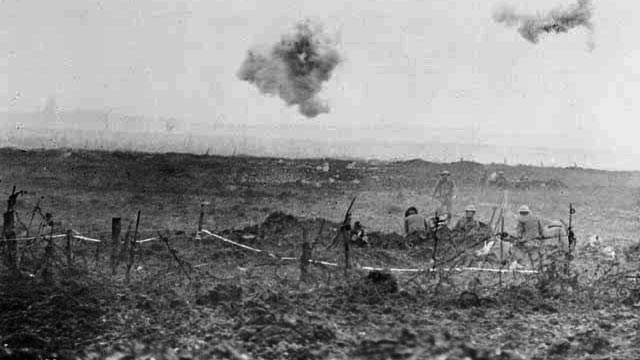Vimy Ridge 1917 – Battlefield Photos
by Glenn Warner
Maple Leaf Up presents the following photo essays:
Vimy Intro – Vimy Ridge April 1917
Vimy 1 – this page – Vimy Battlefield photos April 1917
Vimy 2 – Memorializing the Dead – Constructing the Vimy Memorial 1925-1936
Vimy 3 – Glenn Warner Photography — Vimy Pilgrimage 2007
Vimy in the Battle of Arras
When The Great War broke out in August 1914, the dominion of Canada was still a fledgling nation which had only just gained its 8th and 9th provinces (Saskatchewan and Alberta) less than a decade earlier in 1905, making Canada, for the first time, a contiguous nation from sea to sea. (Britain's other North American dominion – Newfoundland – did not join Canada until 1949.)

Four Canadian Divisions in line on Vimy Ridge. These four divisional colours were continued in the Second World War.
Though much has been made of it, the Battle of Vimy Ridge — April 9th to April 12th 1917 — was truly significant in that Canada fielded a full Corps of 4 Divisions fighting together in line for the first time — one contiguous line of men from nine provinces.
What is largely disregarded in discussing Canada's achievement at Vimy, in northern France, is that the Canadian Corps was only one corps in the British First Army. Canadian soldiers had the British 24th Corps to their left, and the British 17th Corps to their right. The battle for The Ridge was Canada's particular assignment in a much larger overall offensive by three British Armies. The Battle of Arras, fought against the Germans, lasted from 9 April to 16 May 1917, and involved British, Canadian, Australian, New Zealand, and Newfoundland troops.
The name Vimy resonates in Canada, as it should, but it was one of many battles in that offensive — Scarpe, Bullecourt, Lagnicourt, Arleux, Vimy. On 14 April, during the same Arras offensive, the Newfoundland Regiment – part of British 29th Division – suffered heavy losses at Monchy-le-Preux, losing almost 500 battle casualties that day.
While the Canadian Corps opened the Battle of Arras on that Easter Monday, April 9th 1917 with remarkable gains on Vimy Ridge, the overall Battle of Arras made only modest gains in the trade-off, considering the enormous number of dead and wounded.
Canada's official photographer at the time – working for the Canadian War Records Office – was Ivor Castle, manager of the photographic department at London's Daily Mirror. Most if not all of these photos were taken by him. The originals are 4x5 inch glass plate negatives. These photos tell the story of the right flank of the Canadian Corps, not the where the famous Vimy monument is, but towards the southern part of the ridge where 2nd Division met 1st Division.
*****

LAC caption: Advanced reserves digging themselves in under shell fire during the Battle of Vimy Ridge, April 1917. MLU note: This is consolidation after battle. (Library and Archives Canada a1062)

LAC caption: Canadian machine gunners dug in shell holes in Vimy advance, April, 1917. MLU note: Consolidation after battle. Vickers .303 machine guns. (Library and Archives Canada a1079)

LAC caption: The Canadian Light Horse going into action, Vimy Ridge, April 1917. MLU note: The cavalrymen are going into battle or moving up front since they are fully laden with feed bags on the side. The shadows suggest they are moving east, so towards combat. Two gigantic shellbursts hit the ground in the distance. (Photographer William Ivor Castle was not above doctoring his photos for dramatic effect since these cumbersome cameras could not possibly record the true drama unfolding. Hence this shellburst may not be in the original negative.) (Photographer: William Ivor Castle; Library and Archives Canada a1111)

LAC caption: 28th Battalion establishes a Signalling HQ and gets into communication with aeroplanes, April 1917. MLU note: 28th Battalion is from Regina. (Library and Archives Canada a1096)

LAC caption: A machine gun emplacement on the crest of Vimy Ridge and the men who drove the Germans from it during the Battle of Vimy Ridge, April 1917. (Photographer: William Ivor Castle; Library and Archives Canada a1101)

LAC caption: German soldier beyond human aid, Vimy Ridge, April 1917. MLU note: The leather jerkin-clad Canadian soldier, standing over German corpse, is wearing mittens. This photo precedes next photo. Shrapnel shell cloud burst in the sky behind him. (Library and Archives Canada a1126)

LAC caption: Tending a wounded German on the battlefield, Vimy Ridge, April 1917. MLU note: This photo was taken after the photo above. The leather jerkin-clad soldier with the mittens is now on right leaning over dead German body. (German is not "wounded" as the archival caption states, but "beyond human aid" as the previous caption affirms). Now the sequence has more men around, looking for ID etc. Man with 3 ‘pips’ on his shoulder is a captain. Looks like the captain has a trench light slung around his neck as opposed to a camera. Man on left has a square backpack and is most likely an assistant to the photographer Castle shooting this scene. From the previous photo angle, the camera has been moved 90 degrees to the right to take this photo. The dead German has cylindrical gas mask canister; and possibly a satchel of grenades next to that. Soldier with rifle has breach protector on his Enfield. Other soldiers walk in background. (While the LAC has no attribution, the Imperial War Museum attributes this photograph to William Ivor Castle.) (Library and Archives Canada a1121)

LAC caption: Light Railroad truck with wounded on board, Vimy Ridge, April 1917. MLU note: German POWs are bearing a stretcher back to the Field Dressing Station. Only one Canadian soldier is pulling the laden rail truck by the straps. (IWM attributes this photograph to William Ivor Castle.) (Library and Archives Canada a1022)

LAC caption: Bringing in wounded Canadian soldiers from the battlefield, Vimy Ridge, April 1917. MLU note: German POWs again, walking along the light gauge rail. The POW in the foreground is himself a stretcher-bearer. (Library and Archives Canada a1125)

LAC caption: Shrapnel bursting over our troops in the act of digging themselves in at Vimy Ridge, April 1917. MLU note: Questions more than anything. What is the light coloured tape for? There looks to be two teams of men, including one in the distance on the right. The soldiers are not wearing any combat gear and may be artillery or machine gun crews, preparing a gun pit. There is something very large on the extreme left in the distance. (Could it be the abbey at Mont-Saint-Eloi near Vimy?) Some have suggested the shrapnel bursts have been added in afterwards to the photos since the men aren't re-acting. If so the retouchers have done an exceptional job. (Library and Archives Canada a1131)

LAC caption: Canadians searching captured German trenches for Germans still hiding on Vimy Ridge, April 1917. MLU note: This is the junction of a couple of trenches, probably communication as opposed to support trenches. Looks like the door to a German dugout at the tip of the left fork. (Photographer: William Ivor Castle; Library and Archives Canada a1129)

LAC caption: Mule team drawing ammunition on light railway track near Petit Vimy, April 1917. L to R: Gunner Tom Fieldhouse, Ptes. Gerry St. Soucy, Frank Barker, Jackson, Neill, Brown, Gunner W.E. Weaver. MLU note: Exceptional photo where the photographer Castle has taken notes of the names of the mule-drivers. Mule train is hauling a rail car for a light gauge railway. Perhaps they are bringing boxes of ammo to the front. There is a large building over the hill and trees still intact behind them to suggest they are coming from the rear. Many boxes are lying on the ground just on the other side of the rail. Could be some sort of supply depot. In the left foreground are burlap sacks filled with something cylindrical like pots. (Library and Archives Canada a1135)

LAC caption: View over the crest of Vimy Ridge showing the village of Vimy, which was captured by Canadian troops. May 1917. MLU note: It is now May, with officers looking out over the Douai Plain. The city of Lens is off-camera to the left. It is easy to see how important the Ridge was to future consolidations in the area; and also how unassailable it must have seemed before the battle. (Photographer: William Ivor Castle; Library and Archives Canada a1446)

LAC caption: Canadian soldiers returning from Vimy Ridge, May 1917. (Library and Archives Canada a1332)

LAC caption: His Majesty The King on Vimy Ridge interested in German trenches. July 1917. MLU note: George V walks on the duckboard near Vimy Ridge three months after that battle, and two months after the overall Battle of Arras. The height and girth of the man walking behind him definitely suggests it is Canadian Corps commander Arthur Currie. Behind Currie walks the official cinematographer with his wooden tripod and Moy & Bastie camera. (Library and Archives Canada a1536)
The photostory of Vimy Ridge continues next page. ![]()
*****
Hey, we're learning too. If you have any observations, comments, insights, or see any errata, typos, or anything nutty when viewing these photos, please contact us. (Refer to photo reference numbers if possible.)





